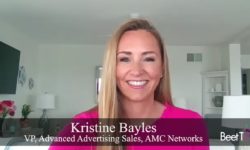LONDON – Although the common view is that, during the first year of the COVID-19 pandemic, all kinds of TV platform saw increased viewing, Vicky Fox has a different story.
On top of a general reduction in linear TV viewing, the chief planning officer at OMD UK says casual TV viewers are drifting away, too.
It all adds up to a picture in which brands are increasingly struggling to use TV to find their audiences. And that is why Fox re-organised her team.
Linear reach is shrinking
“If you just stuck with linear buys, the reduction in (audience) viewing is really clear over time,” Fox observes, in this video interview with Beet.TV senior advisor Jon Watts.
“Even if you strip out the COVID 2020 viewing patterns, what we’re seeing is reach build(ing) is a real challenge for linear TV.”
“I’ve run some numbers the other day – the light TV viewers in (the) linear space has halved over the last few years. It was 8% to now just over three (percent)
Light viewers leaving
Fox says the pattern was even observable at a time when it seemed like TV viewing was booming from stay-at-home orders.
“Even during COVID, light viewers were not attracted to the linear TV experience,” she adds.
“So, it really does need someone who understands both those worlds to bring them together, to know how much to spend in linear, which does do a really strong initial reach build for people who enjoy linear, and then what to do to reach all those people who may be light TV viewers.
“They may be working longer hours, they may be younger, they may be fans of lots of other different types of engagement. You need to sort of understand how those whole ecosystems come together.”
Restructure to combine
About three years ago, Fox reorganised her team at OMD UK to tag-team ad planning for linear and connected TV, which is emerging as a key way in which media agencies are trying to make up for the shortfall in linear viewing.
“The first thing we did was bring together different teams that probably hadn’t worked together before,” Fox explains.
“We created a connections planning department, which was built from people who were either very used to planning in a linear way historically, and then brought them together with digital experts, the people who are used to planning programmatically, addressably.
“When you start to blend those two languages together … you get really robust plans. You get the balance of a mass reach with some moments of really strong targeting lines that are going to be really hard working.”
The benefits of CTV
Connected TV is important for a variety of reasons.
Fox says extra data on viewers allows her to better target ads.
That is critical in a world where audience “self-scheduling is going to be the norm for everyone”, she says.
“A connected device means that we have more data on that person – not in a creepy way, (but) in a way that it makes the whole viewing experience better for them because we can serve them advertising that is much more relevant, which is great.”
You are watching “What’s Next For Advertisers? Key Changes That Will Drive The Industry Forward,” a Beet.TV leadership series presented by Comcast Technology Solutions. For more videos, please visit this page. For Comcast Technology Solutions’ paper on these topics, please visit this link.


































